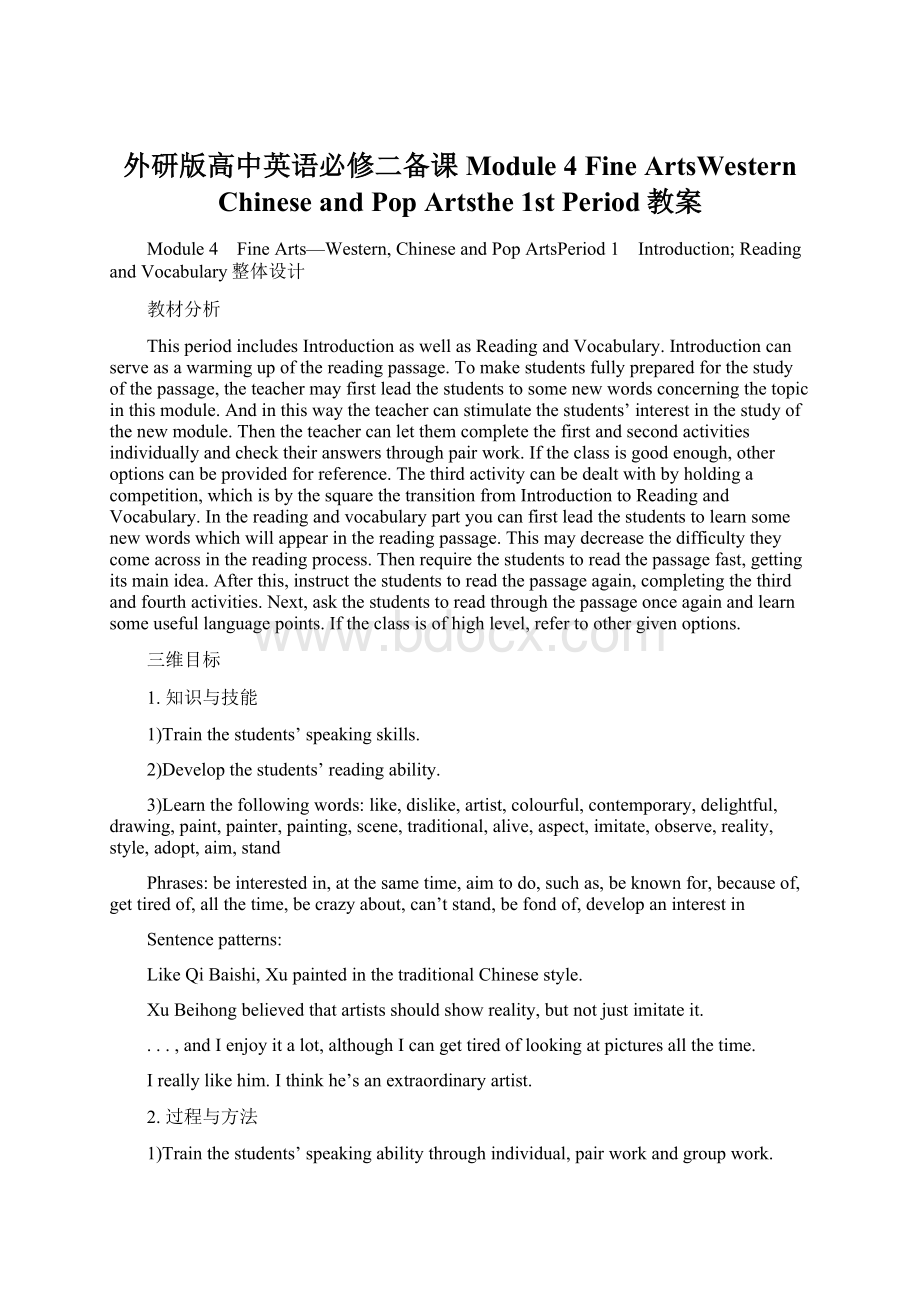外研版高中英语必修二备课Module 4 Fine ArtsWestern Chinese and Pop Artsthe 1st Period教案.docx
《外研版高中英语必修二备课Module 4 Fine ArtsWestern Chinese and Pop Artsthe 1st Period教案.docx》由会员分享,可在线阅读,更多相关《外研版高中英语必修二备课Module 4 Fine ArtsWestern Chinese and Pop Artsthe 1st Period教案.docx(17页珍藏版)》请在冰豆网上搜索。

外研版高中英语必修二备课Module4FineArtsWesternChineseandPopArtsthe1stPeriod教案
Module4 FineArts—Western,ChineseandPopArtsPeriod1 Introduction;ReadingandVocabulary整体设计
教材分析
ThisperiodincludesIntroductionaswellasReadingandVocabulary.Introductioncanserveasawarmingupofthereadingpassage.Tomakestudentsfullypreparedforthestudyofthepassage,theteachermayfirstleadthestudentstosomenewwordsconcerningthetopicinthismodule.Andinthiswaytheteachercanstimulatethestudents’interestinthestudyofthenewmodule.Thentheteachercanletthemcompletethefirstandsecondactivitiesindividuallyandchecktheiranswersthroughpairwork.Iftheclassisgoodenough,otheroptionscanbeprovidedforreference.Thethirdactivitycanbedealtwithbyholdingacompetition,whichisbythesquarethetransitionfromIntroductiontoReadingandVocabulary.Inthereadingandvocabularypartyoucanfirstleadthestudentstolearnsomenewwordswhichwillappearinthereadingpassage.Thismaydecreasethedifficultytheycomeacrossinthereadingprocess.Thenrequirethestudentstoreadthepassagefast,gettingitsmainidea.Afterthis,instructthestudentstoreadthepassageagain,completingthethirdandfourthactivities.Next,askthestudentstoreadthroughthepassageonceagainandlearnsomeusefullanguagepoints.Iftheclassisofhighlevel,refertoothergivenoptions.
三维目标
1.知识与技能
1)Trainthestudents’speakingskills.
2)Developthestudents’readingability.
3)Learnthefollowingwords:
like,dislike,artist,colourful,contemporary,delightful,drawing,paint,painter,painting,scene,traditional,alive,aspect,imitate,observe,reality,style,adopt,aim,stand
Phrases:
beinterestedin,atthesametime,aimtodo,suchas,beknownfor,becauseof,gettiredof,allthetime,becrazyabout,can’tstand,befondof,developaninterestin
Sentencepatterns:
LikeQiBaishi,XupaintedinthetraditionalChinesestyle.
XuBeihongbelievedthatartistsshouldshowreality,butnotjustimitateit.
...,andIenjoyitalot,althoughIcangettiredoflookingatpicturesallthetime.
Ireallylikehim.Ithinkhe’sanextraordinaryartist.
2.过程与方法
1)Trainthestudents’speakingabilitythroughindividual,pairworkandgroupwork.
2)Trainthestudents’readingskillsbydealingwithsomereadingactivities.
3)Explanationstomakethestudentsmastersomelanguagepoints.
4)Fastreadingtomakethestudentsgetthemainideaofthepassage.
3.情感与价值
1)Trytoraisethestudents’cooperativeawarenessintheirstudybypairworkorgroupwork.
2)Requestthestudentstolovearts,especiallypaintings.
教学重点
1.Encouragethestudentstotalkaboutartsaswellasthewell-knownartistsathomeandabroad.
2.Helpthestudentsmakesenseofthepassage.
3.Helpthestudentstoimprovetheirreadingability.
教学难点
1.Leadthestudentstotalkinclassactively.
2.Dealwithsomedifficultlanguagepoints.
教学过程
→Step1Lead-inandIntroduction
1.Askthestudentstoanswerthefollowingquestionsandleadinthenewclass.
Whohasbeentoanartgallery?
Ifso,whatdidyouseethere?
Whatdoyouenjoymost?
Canyougiveanaccountofit?
2.Activity1
Option1
ShowsomepicturesorrealobjectsonthescreenwhichcanhelpthestudentstounderstandthelistedwordsintheboxinthefirstactivityonP31.Ifnecessary,theteachercangivesomeexplanations.Thenthestudentsreadthembythemselvesandtrytorememberthem.Next,askthestudentstoworkinpairstoanswerthequestionsinthefirstactivityandtheycanrefertothelistedwords.Finally,callbacktheanswersfromthewholeclass.
Option2
Readthroughthewordsinthefirstactivityonebyoneasthestudentsfollowyou.Makesuretheyunderstandwhatthesewordsmean.Thenhavethestudentsworkinpairsandanswerthequestionsinthefirstactivity.Afterthis,comparetheiranswerswithotherpairs.Next,volunteersspeakouttheiranswersandotherstudentscheckiftheymakeanymistakes.
Option3
Thestudentsreadthewordsintheboxindividuallyandunderlinethosetheycan’treadordon’tknowatall.Theteacherexplainsthemorencouragestheexcellentstudentstodoso.Thenputtheclassintogroupsoffourtodiscussthequestions.Finally,letsomerepresentativesdescribethemusingtwoormoresentences.
Option4
Dividethewholeclassintotwobiggroupsandholdacompetition.Eachgroupbrainstormsasmanywordsconcerningartistsaswellasartisticworksaspossible.Thegroupwhichgivesmorecorrectwordswillbethewinner.Theneachgroupdiscussesthelistedquestionsamongitsgroupmembers.
3.Activity2
Option1
Theteacherdisplayssomepicturespreparedbeforeclasstothewholeclassandgivesamodellikethis:
nowlookatthesepaintings.Ienjoytheoneontheleftmost.I’dliketogiveitatitle.Inmyopinion,thepropertitleshouldbe_________.Itisvividbecause...Thenthestudentschoosetheirfavouritepicturesanddoastheteachershowedthem.Finally,representativesarerequiredtogiveareport.
Option2
Askthestudentstolookthroughandappreciatethethreelistedpicturesindividuallyandchooseonetheyprefermost.Thenputthestudentsintogroupsonthebasisofthepicturestheychoosetodiscussthem,givingapropertitleanddescribingthemwithacoupleofsentences.Finally,representativesofeachgroupgiveabriefreport.
Option3
Thestudentsshowthepicturestheypreparedbeforehandtothewholeclass.Putthestudentsintopairsorgroupsoffourtodiscussthemandgiveeachofthemapropertitle.Thenthestudentscheckiftheirpicturesarecorrectlytitled.Next,eachpairorgroupchoosestheirfavouritepictureanddescribesitusingtwoorthreesentences.Finally,asksomestudentstoreporttheirdescriptiontothewholeclass.
→Step2Pre-reading
1.Backgroundknowledgeoftheartistsathomeandabroad
Firstputthestudentsintogroupsoffourandaskthestudentstodiscusshowmuchtheyknowabouttheartistsathomeandabroad.Thensomevolunteersreporttheirdiscussionresultstothewholeclass.
2.Showthefollowingwordsonthescreen.Havethestudentsreadthemafteryouandmakesuretheyknowwhattheymean.Iftheycan’tunderstandanyofthem,theycanturntoyouforhelporlookthemupinthereferencebook,forexample,adictionary.Thenmatchthewordswiththedefinitionsbelow.
(Showthefollowingonthescreen.)
alive aspect imitate (art)movement observe ordinary reality style
Suggestedanswers:
1style 2observe 3movement 4imitate 5alive 6ordinary 7aspect 8reality
→Step3While-reading
1.Scanning
Option1
FirstaskthestudentstolookthroughthefourpicturesonP32quicklyandtrytounderstandthem.Thenhavethestudentsreadthepassageandcompletethetwoexerciseslistedinthisactivity.Next,putthestudentsintopairstocomparetheiranswers.Finally,callbacktheanswersfromtheclass.
Suggestedanswers:
1)1—C;2—A;3—D;4—B
2)E—1,4;F—3,2
Option2
Firstofall,askthestudentstoreadthepassagequicklyandsummarisethemainideaofeachparagraphindividually.Andthenputthestudentsintogroupsoffourtocomparetheirmainideasandchoosewhattheythinkthebestonesarebydiscussing.Next,representativesofsomegroupsreporttheirmainideastothewholeclass.Finally,showthecorrectanswersonthescreenfortheclasstoreferto.
Suggestedanswers:
Paragraphone:
PabloPicassoandCubism.
Paragraphtwo:
RoyLichtensteinandpopart
Paragraphthree:
QiBaishiandChinesepainting
Paragraphfour:
XuBeihong---oneofChina’sbest-knowntwentieth-centuryartists
Paragraphfive:
WuHang’sopinionsonarts
Paragraphsix:
SarahHardwick’sopinionsonarts
2.Carefulreading
Option1
First,showthefollowingsentencesonthescreenandaskthestudentstoreadthemthroughquicklyandtrytounderstandthem.Thenhavethestudentsreadthepassageagainanddecideifthesesentencesaretrue(T)orfalse(F).Next,putthestudentsintopairstocomparetheiranswers.Finally,callbacktheanswersfromtheclass.
(Showthefollowingonthescreen.)
1PabloPicassoisconsideredtobethegreatestwesternartistofthenineteenthcentury.
2Popartwasanimportanttraditionalartmovementaimingtoshowordinarytwentieth-centurycitylife.
3BothQiBaishiandXuBeihongpaintedusingthetraditionalChinesestyle.
4WuHangisastudentwhoenjoysthepaintingsofQiBaishigreatly.
5SarahlovesnottheChinesepaintingsbutthatofPicasso’s.
Suggestedanswers:
1F 2F 3T 4T 5F
Option2
Firsthavethestudentsreadthepassageoncemoretofindtherelatedinformationofthefollowingyearsandcompletethetable.Thenputthestudentsintopairstoexchangeandchecktheiranswers.Afterthis,representativesreporttheiranswerstothewholeclass.Theteachercommentsonthem,andthenoffersthecorrectanswersforthestudentstochecktheirown.
Lifetime
Artists
Nationality
Styleofpainting
Thingspainted
1881-1973
1923-1927
1863-1957
1895-1953
Suggestedanswers:
Lifetime
Artists
Nationality
Styleofpainting
Thingspainted
1881-1973
PabloPicasso
Spain
Cubism
objectsandpeople
1923-1927
RoyLictenstein
America
popart
ordinarytwentieth-centurycitylife
1863-1957
QiBaishi
China
traditionalChinesestyle
worldofnature
1895-1953
XuBeihong
China
traditionalChinesestyle
horses
3.Consolidation
Option1
Firstputthestudentsintogroupsoffouranddiscusshowtoretellthefirstfourparagraphswiththehelpoftheusefulinformationinthetableabove.Givethemsometimetomakefullpreparations.Wh